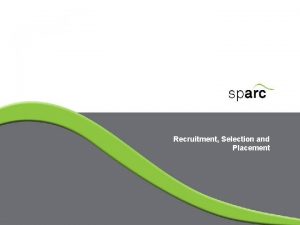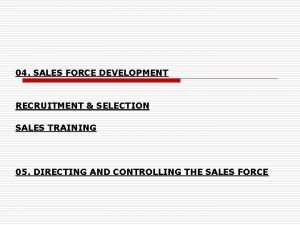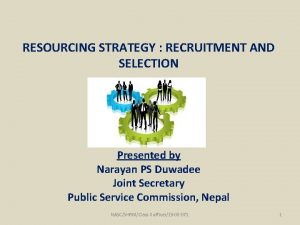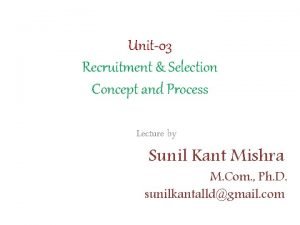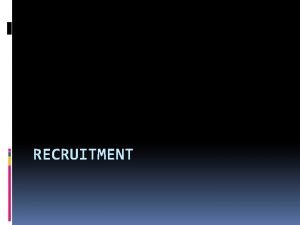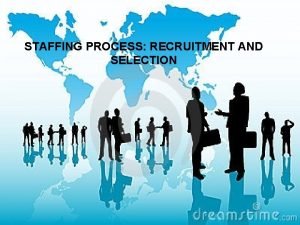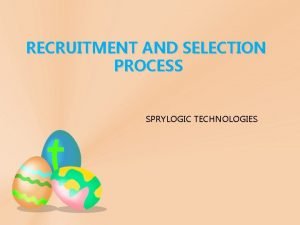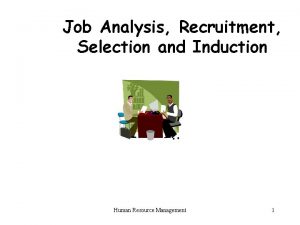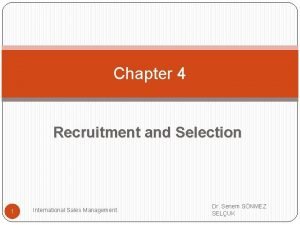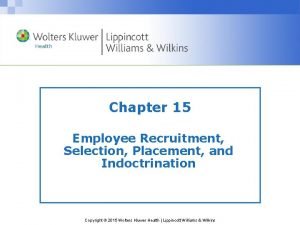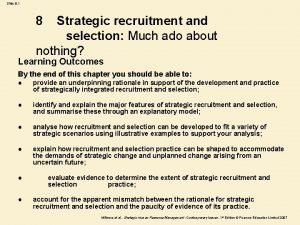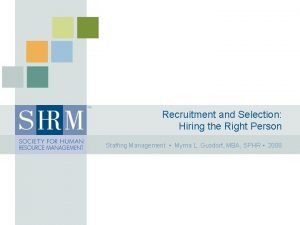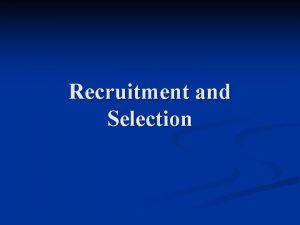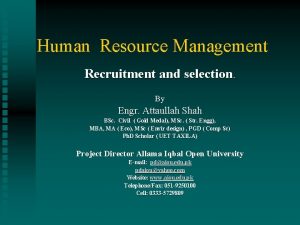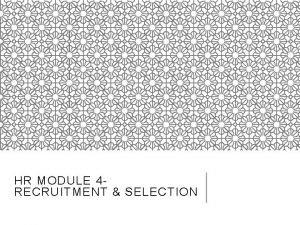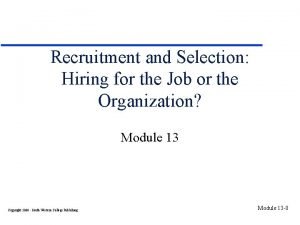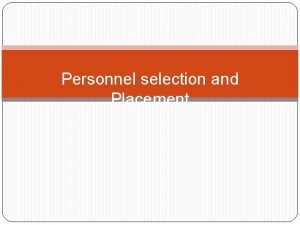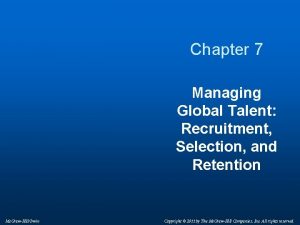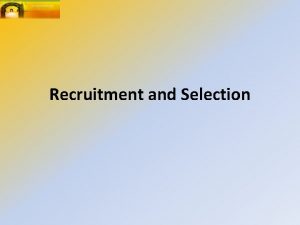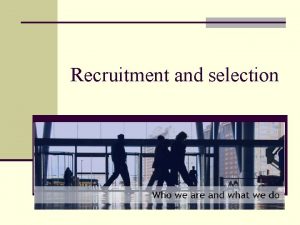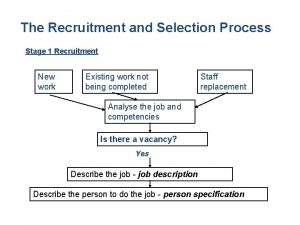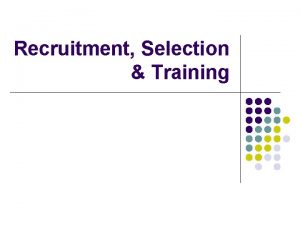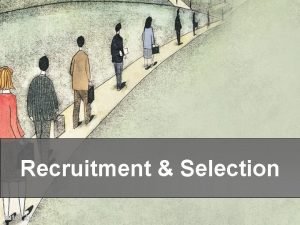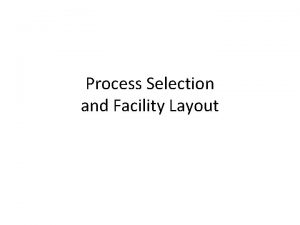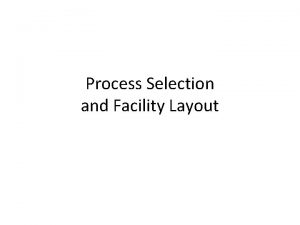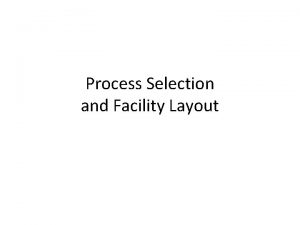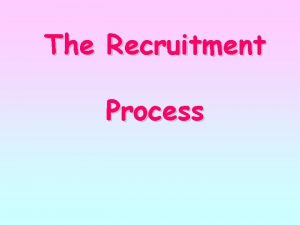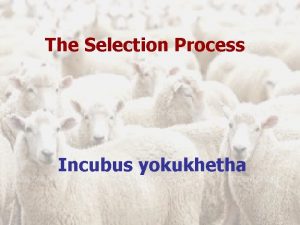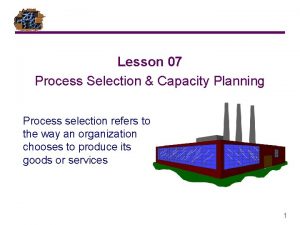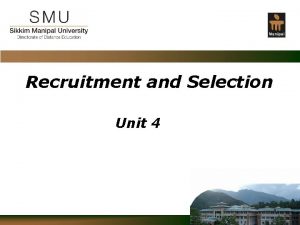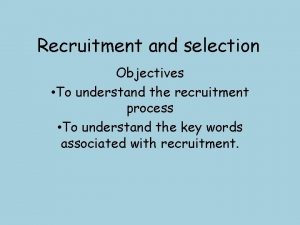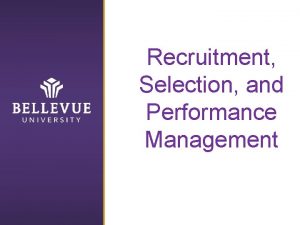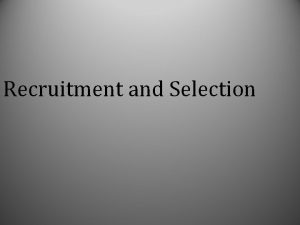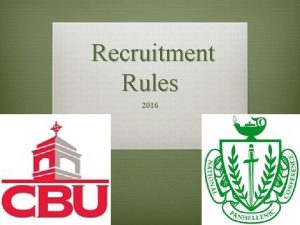RECRUITMENT AND SELECTION Recruitment Recruitment is the process
































- Slides: 32

RECRUITMENT AND SELECTION Recruitment : Recruitment is the process of identifying that the organization needs to employ someone up to the point at which application forms for the post have arrived at the organization. Selection : Selection consists of the processes involved in choosing from applicants a suitable candidate to fill a post.



Sources of Recruitment has two types of sources : 1. Internal sources of Recruitment. 2. External sources of Recruitment. Let we study detail on the above sources of recruitment: INTERNAL SOURCES OF RECRUITMENT : Introduction : • Recruiting may bring to mind employment agencies and classified ads, but current employees are often the best source of candidates.

• Filling open positions with inside candidates has many benefits. • First, there is really no substitutes for knowing a candidates strengths and weaknesses. It is often therefore safer to promote employees from within, since your are likely to have a more accurate view of the persons skills. • Inside candidates may also be more committed to the company. • Morale may rise if employees see promotions as rewards for loyalty and competence. • Inside candidates may also require less orientation and training than outsiders.

Finding Internal Candidates : • To be effective, promotion within requires using job posting , personnel records, and skills banks. • Job posting means publicizing the open job to employees (often by literally posting it on bulleting boards or intranets) and listing the jobs attributes , like qualifications, supervisor, work schedule, and pay rate. • Qualifications personnel inventory tools like those described earlier ( such as computerized skills banks ) are also important. • An examination of personnel records may reveal employees who are working in jobs below their educational or skill levels.

• It may also reveal persons who have potential for further training or who already have the right background for the open job. • Computerized records systems can help ensure that you consider qualified inside candidates for the opening. Rehiring: • Rehiring former employees has its pros and cons. On the plus side, former employees are known quantities (more or less), and are already familiar with the company’s culture, style, and ways of doing things.

• On the other hand, employees who were let go may return with less – than- positive attitudes. • And hiring former employees who left for greener pastures back into better positions may signal your current employees that the best way to get ahead is to leave the firm. Succession Planning : Succession planning entails three steps : 1. Identifying and analyzing key jobs, 2. Creating and assessing candidates and 3. Selecting those who will fill the key positions.

External Sources of Recruiting Word of mouth Advertisements Employment agencies • Private • Public • Executive search firms/headhunters Techniques for Recruiting College placement offices Copyright © 2012 by Cengage Learning. All rights reserved. Electronic recruiting 7 - 9

EXTERNAL SOURCES OF RECRUITMENT : Firms can’t always get all the employees they need from their current staff, and sometimes they just don’t want to. Advertising • Everyone is familiar with employment ad’s, and most of us have probably responded to one or more. • While Web-based recruiting is replacing help wanted ads to some extent, a quick look at almost any paper or business or professional magazine will confirm that two issues : the advertising medium and the ad’s construction.

The Media : • The selection of the best medium - be it the local paper, the Wall Street Journal, TV or Internet – depends on the position for which you are recruiting • For example, the local newspaper is usually the best source for blue – collar help, clerical employees, and lower – level administrative employees. • For specialized employees, you can advertise in trade and professional journals like “American Psychologist, Sales Management, Chemical Engineering, Electronics News, Travel Trade, and Women Wear Daily.

Constructing the Ad : • Experienced advertisers use a four – point guide called AIDA ( attention, Interest, desire, action ) to construct ad’s. • Employers usually advertise key positions in separate display ad’s. • Develop interest in the job. You can create interest by the nature of the job itself, with lines such as “ outstanding opportunities for advancement”. • Create desire by spotlighting the job’s interest factors with words such as ‘travel or challenge’. Keep your target audience in mind. For example, having a graduate school nearby may appeal to engineers and professional people.


Employment Agencies There are three main types of employment agencies: 1. Public Agencies operated by federal, state or local governments, 2. Agencies associated with non profit organizations, and 3. Private owned agencies.

PUBLIC AND NON PROFIT AGENCIES : • Every state has a public, state – run employment service agency. • The U. S Dept of labor supports these agencies, through grants and through other assistance such as nationwide computerized job bank. • Most (non profit) professional and technical societies, such as the institute for Electrical and Electronic Engineers (IEEE), have units that help members find jobs,

PRIVATE AGENCIES : • Private employment agencies are important sources of clerical, whitecollar, and managerial personnel. • They charge fees (set by state law and posted in their offices) for each applicant they place. Most are “fee – paid’’ jobs, in which the employer pays the fee. Why use an agency ? Reasons include: • Your firm doesn’t have its own human resources department and feels it can’t do a good job recruiting and screening. • You want to reduce the time you are devoting to recruiting.

TEMPORARY AGENCIES AND ALTERNATIVE STAFFING : • Employers increasingly supplement their permanent workforces by hiring contingent or temporary workers, often through temporary help employment agencies. Also known as part – time or just-in-time workers, the contingent workforce is big and growing. • The contingent workforce is not limited to clerical or maintenance staff. • It includes thousands of engineering, science, or management support occupations, such as temporary chief financial officers, human resource managers, and chief executive officers.

Temporary agencies and alternative staffing – Pros and cons : • Employers have long used ‘’temps’’ to fill in for permanent employees who were out sick or on vacation. • But todays desire for ever- higher productivity also contributes to temps workers growing popularity. • Productivity is measured in terms of out per hour paid for, and temps are generally paid only when they are working – not for days off, in other words.

SELECTION Introduction : • With pool of applicants, the next step is to select the best candidates for the job. • The prospective supervisor can interview likely candidates and decide who to hire.

Careful Selection is Important Selecting the right employees is important for three main reason. • Employees with the right skills and attributes will do a better job for you and the company. Employees without these skill or who are abrasive or obstructionist won’t perform effectively , and your own performance and the firms will suffer. The time to screen out undesirables is before they are in the door, not after. • Second, it is important because its costly to recruit and hire employees. Hiring and training even a clerk can cost $5000 or more in fees and supervisory time. The total cost of hiring a manager could easily be 10 times as high once you add search fees, interviewing time, reference checking, and travel and moving expenses.

• Third, Its important because of the legal implications of incompetent hiring. For one thing, EEO laws and court decisions require nondiscriminatory selection procedures for protected groups.

The Selection Process

The Selection Process INTRODUCTION : Selection activities follow a standard pattern, beginning with an initial screening interview and concluding with the final employment decision. The Selection process typically consists of eight steps : 1. INITIAL SCREENING : The initial screening is, in effect, a two step procedure a) Screening Inquiries and b) Screening interviews.

a) Screening Inquiries : • If the company’s recruiting effort has been successful, they will have a pool of potential applicants. • The organization can eliminate some of these respondents based on the job description and job specification. b) Screening Interviews : • The screening interview is also an excellent opportunity for HRM to describe the job in detail so the candidates can consider if they are really serious about applying.

• Phone interviews are efficient ways to hold screening interviews. • Listen for energy and enthusiasm in their voice, and remember to project the company culture or employment ‘’brand”. The candidate is evaluating you and the organization too. • Be sure to tell them when the next step will occur and what to expect.

2. COMPLETING THE APPLICATION FORM : After the phone screening interview, applicants may be asked to complete the organizations application form. • Briefing only the applicants name, address, and telephone number. • Most organizations, on the other hand, may want a more comprehensive employment profile. • In general terms, the application form gives a job-performance related synopsis of applicants life, skills and accomplishments.

3. PRE EMPLOYMENT TESTING : • Preemployment tests are quite helpful in predicting who will be successful on the job. • Literally hundreds of tests can serve as selection tools. • They can measure intellect, spatial ability ( the capacity to understand, reason and remember the relations among objects or space), perception skills, mechanical comprehensions, motor ability or personal traits.

4. COMPREHENSIVE INTERVIEWS : • A Selection device used to obtain in depth information about a candidate. • Applicants who pass the initial screening, application form, and required tests typically receive a comprehensive interview. • The comprehensive interview is designed to probe areas not easily addressed by the application form or tests, such as assessing a candidates motivation, values, ability to work under pressure, attitude, and ability to ‘’fit in’’ with the organization culture.

5. CONDITIONAL JOB OFFER : • If a job applicant has passed each step of the selection process so far, a conditional job offer is usually made. • Conditional job offer usually comes from an HRM representative. • In essence, the conditional job offer implies that if everything checkouts – such as passing a certain medical, physical or substance abuse test – the conditional nature of the job offer will be removed and the offer will be permanent.

6. BACKGROUND INVESTIGATION : • Back ground investigations, or reference checks, are intended to verify that information on the application is correct and accurate. • Sometimes just notifying applicants that the firm will check all references and former employers is enough to keep them from falsifying any information. • HRM must always remember to ask the candidate to sign a waiver giving the organization permission to check court records, references, former employers and education.

7. MEDICAL/PHYSICAL EXAMINATION : • An examination to determine an applicants physical fitness for essential job performance. • Physical exams can only be used as a selection device to screen out individuals who are unable to physically comply with the requirements of a job. • For example, fire fighters must perform activities that require a certain physical condition. Whether it is climbing a ladder, lugging a water- filled four-inch hose, or carrying an injured victim, these individuals must demonstrate that they are fit for the job.

8. JOB OFFERS : • Individuals who perform successfully in the preceding steps are now considered eligible to receive the employment offer. • The offer typically is made by an HRM representative.
 Recruitment and selection course outline
Recruitment and selection course outline Recruitment and selection of sales force ppt
Recruitment and selection of sales force ppt Recruitment selection and induction policies and procedures
Recruitment selection and induction policies and procedures Objectives of resourcing strategy
Objectives of resourcing strategy Recruitment meaning
Recruitment meaning Casual callers meaning
Casual callers meaning Selection in staffing
Selection in staffing Recruitment and selection definition
Recruitment and selection definition How is recruitment different from selection
How is recruitment different from selection Personnel recruitment and selection
Personnel recruitment and selection Job analysis recruitment and selection
Job analysis recruitment and selection Exam questions on human resource management
Exam questions on human resource management International sales recruitment
International sales recruitment The new recruit chapter 15
The new recruit chapter 15 Strategic view of recruitment & selection
Strategic view of recruitment & selection Recruitment and selection: hiring the right person
Recruitment and selection: hiring the right person Definition of recruitment and selection
Definition of recruitment and selection Trends in recruitment and selection
Trends in recruitment and selection Selection in human resource management
Selection in human resource management Recruitment and selection definition
Recruitment and selection definition Recruiting yield pyramid
Recruiting yield pyramid Difference between hiring and recruitment
Difference between hiring and recruitment Personnel selection definition
Personnel selection definition Two way selection and multiway selection
Two way selection and multiway selection Multiway selection
Multiway selection Procedure of pure line selection
Procedure of pure line selection Global recruitment selection
Global recruitment selection Balancing selection vs stabilizing selection
Balancing selection vs stabilizing selection Similarities
Similarities K selection r selection
K selection r selection Natural selection vs artificial selection
Natural selection vs artificial selection Artificial selection vs natural selection
Artificial selection vs natural selection What is disruptive selection
What is disruptive selection
